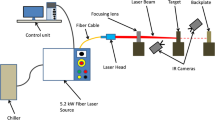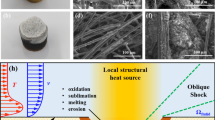Abstract
As a kind of high temperature resistant material, glass fiber-reinforced epoxy resin (GFRE) plate is widely used in aviation and machinery fields. When GFRE is exposed to high temperature and high-speed airflow, it undergoes severe ablation, which affects its material and internal structure. In order to investigate the thermal effects and ablation behavior under high heat flux, a continuous laser was used to ablate a GFRE plate with different laser power levels. Then, a two-dimensional finite element model of laser ablation of GFRE was developed, taking into account the depth-dependent absorption of laser energy and the enthalpy change caused by the pyrolysis reaction. The mass loss results from the model were compared with those from the experiment and showed reasonable validity. Moreover, the changes in the internal composition of GFRE during ablation were also analyzed based on the experiment and model. It was found that the epoxy resin content decreased rapidly during ablation while the dehydrated epoxy resin and carbides increased continuously. Dehydration reaction was found to be the main factor for mass loss. Furthermore, the surface layer had more heat dissipation by convection and radiation than the deep layer. Hence, the chemical reactions in the surface layer ceased almost instantly after stopping the laser. However, the chemical reactions in the deep layer persisted for some time after removing the heat source.







Similar content being viewed by others
References
Barriault RJ, Yos J. Analysis of the ablation of plastic heat shields that form a charred surface layer. ARS J. 1960;30:823–9.
Curry DM. An analysis of a charring ablation thermal protection system. NASA TN D-3150. 1965
John A. Dec RDB. An approximate ablative thermal protection system sizing tool for entry system design. In: 44th American institute for aeronautics and astronautics (AIAA) aerospace sciences meeting and exhibit. Georgia institute of technology. 2006
Curry DM. Thermal protection systems manned spacecraft flight experience. NASA Langley Res Center. 1992: 19–41
Henderson JB, Wiebelt JA, Tant MR. A model for the thermal response of polymer composite materials with experimental verification. J Compos Mater. 1985;19:579–95.
Wu C, Wu X, Huang C. Ablation behaviors of carbon reinforced polymer composites by laser of different operation modes. Opt Laser Technol. 2015;73:23–8.
Li W, Huang H, Xu X, Guo J. A new mechanism of surface ablation of charring materials for a vehicle during reentry. Appl Therm Eng. 2016;106:838–49.
Li W, Huang H, Zhang Z, Xu X. Effects of gradient density on thermal protection performance of avcoat composites under varied heat flux. Polym Compos. 2016;37:1034–41.
Li W, Huang H, Xu X. A coupled thermal/fluid/chemical/ablation method on surface ablation of charring composites. Int J Heat Mass Transf. 2017;109:725–36.
Li W, Huang H, Wang Q, Zhang Z. Protection of pyrolysis gases combustion against charring materials’ surface ablation. Int J Heat Mass Transf. 2016;102:10–7.
Henderson JB, Wiecek TE. A mathematical model to predict the thermal response of decomposing, expanding polymer composites. J Compos Mater. 1986;21:373–93.
McCarthy ED, Kandola BK, Edwards G, Myler P, Yuan J, Wang YC, Kandare E. Modelling flaming combustion in glass fibre-reinforced composite laminates. J Compos Mater. 2013;47:2371–84.
Chippendale RD, Golosnoy IO, Lewin PL. Numerical modelling of thermal decomposition processes and associated damage in carbon fibre composites. J Phys D Appl Phys. 2014;47:385301.
Paglia L, Tirillo J, Marra F, Bartuli C, Simone A, Valente T, Pulci G. Carbon-phenolic ablative materials for re-entry space vehicles: plasma wind tunnel test and finite element modeling. Mater Des. 2016;90:1170–80.
Huang H, Li W, Yu H. Thermal analysis of charring materials based on pyrolysis interface model. Therm Sci. 2014;18:1591–6.
Mouritz AP, Gibson AG. Fire properties of polymer composite materials. ACI Struct J. 2006;105(1):60–7.
Chen Y, Milos FS. Multidimensional finite volume fully implicit ablation and thermal response code. J Spacecr Rocket. 2018;55:914–27.
Li W, Zhang J, Fang G, Li W, Liang J, Meng S. Evaluation of numerical ablation model for charring composites. Sci China Technol Sci. 2019;62:1322–30.
Incropera FP, Dewitt DP, Bergman TL, Lavine AS. Fundamentals of heat and mass transfer. 6th ed. Wiley; 2006.
Arnold N, Bityurin N, Bäuerle D. Laser-induced thermal degradation and ablation of polymers: bulk model. Appl Surf Sci. 1999;138–139:212–7.
Strouhal G, Curry D (1966) Thermal protection system performance of the apollo command module. In: Proceedings of the 7th structures and materials conference (1966) https://doi.org/10.2514/6.1966-1718
Kandare E, Kandola BK, Staggs JEJ. Global kinetics of thermal degradation of flame-retarded epoxy resin formulations. Polym Degrad Stab. 2007;92:1778–87.
Wang Y, Risch TK, Pasiliao CL. Modeling of pyrolyzing ablation problem with abaqus: a one-dimensional test case. J Thermophys Heat Transf. 2018;32:544–8.
Gong J, Chen Y, Li J, Zhou Y. Numerical simulation of pyrolysis of pmma involving surface and in-depth absorption. J Zhejiang Univ. 2016;50:1879–88.
Jiang F, Ris JLD, Khan MM. Absorption of thermal energy in pmma by in-depth radiation. Fire Saf J. 2009;44:106–12.
Linan A, Williams FA. Radiant ignition of a reactive solid with in-depth absorption. Combust Flame. 1972;18:85–97.
Staggs JEJ. Heat and mass transport in developing chars. Polym Degrad Stab. 2003;82:297–307.
Farkas E, Meszena ZG, Toldy A, Matkó S, Marosfői BB, Marosi G. Modelling of transport processes in a developing char. Polym Degrad Stab. 2008;93:1205–13.
Herr NC, Gonzales AE, Perram GP. Kinetics, evolving thermal properties, and surface ignition of carbon fiber reinforced epoxy composite during laser-induced decomposition. Polym Degrad Stab. 2018;152:147–61.
Potts RL. Application of integral methods to ablation charring erosion, a review. J Spacecr Rocket. 1995;32:200–9.
Rose N, Bras LM, Delobel R. Thermal oxidative degradation of an epoxy resin. Polym Degrad Stab. 1993;42:307–16.
Rose N, Bras LM, Bourbigot S, Delobel R. Thermal oxidative degradation of epoxy resins: evaluation of their heat resistance using invariant kinetic parameters. Polym Degrad Stab. 1994;45:387–97.
Rose N, Bras LM, Bourbigot S, Delobel R, Costes B. Comprehensive study of the oxidative degradation of an epoxy resin using the degradation front model. Polym Degrad Stab. 1996;54:355–60.
Kandare E, Kandola BK, McCarthy ED, Myler P, Edwards G, Yong J, Wang YC. Fiber-reinforced epoxy composites exposed to high temperature environments. Part ii modeling mechanical property degradation. J Compos Mater. 2011;45:1511–21.
Chairat A, Joulia X, Floquet P, Vergnes H, Ablitzer C, Fiquet O, Brothier M. Thermal degradation kinetics of a commercial epoxy resin-comparative analysis of parameter estimation methods. J Appl Polym Sci. 2015;132:42201.
Chen KS, Yeh RZ. Pyrolysis kinetics of epoxy resin in a nitrogen atmosphere. J Hazard Mater. 1996;49:105–13.
Kumar R. Numerical investigation of gas-surface interactions due to ablation of high-speed vehicles. J Spacecr Rocket. 2016;53:538–48.
Kalogiannakis G, Hemelrijck DV, Assche GV. Measurements of thermal properties of carbon/epoxy and glass/epoxy using modulated temperature differential scanning calorimetry. J Compos Mater. 2004;38:163–75.
Acknowledgements
The authors would like to thank the National Natural Science Foundation of China (NSFC Grant 52176114) and the Postgradutae Research & Practice Innovation Program of Jiangsu Province (No. KYCX22_0477). Meanwhile, the authors would like to thank Dr. Han Zhongxuan for his help in polishing the language.
Funding
Lin Jiang reports financial support was provided by the National Natural Science Foundation of China. Xinrui Yang reports equipment, drugs, or supplies were provided by Postgradutae Research & Practice Innovation Program of Jiangsu Province. Mi Li reports financial support was provided by the National Natural Science Foundation of China.
Author information
Authors and Affiliations
Contributions
XY conducted the experiments and simulations and wrote the manuscript. LJ gave some plans and suggestions for manuscript writing. ML gave some suggestions for manuscript writing and polished the manuscript.
Corresponding author
Additional information
Publisher's Note
Springer Nature remains neutral with regard to jurisdictional claims in published maps and institutional affiliations.
Rights and permissions
Springer Nature or its licensor (e.g. a society or other partner) holds exclusive rights to this article under a publishing agreement with the author(s) or other rightsholder(s); author self-archiving of the accepted manuscript version of this article is solely governed by the terms of such publishing agreement and applicable law.
About this article
Cite this article
Yang, X., Jiang, L. & Li, M. Modeling continuous laser ablation of glass fiber-reinforced epoxy resin plate with two-dimensional finite element. J Therm Anal Calorim 148, 10583–10594 (2023). https://doi.org/10.1007/s10973-023-12229-7
Received:
Accepted:
Published:
Issue Date:
DOI: https://doi.org/10.1007/s10973-023-12229-7




